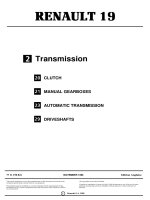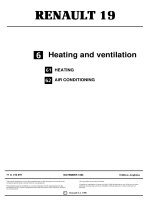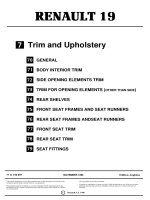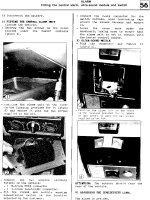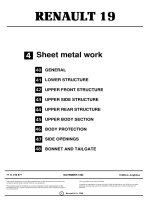Tài liệu sửa chữa xe ô tô Renault 19 (Repair Manual) - P4
Bạn đang xem bản rút gọn của tài liệu. Xem và tải ngay bản đầy đủ của tài liệu tại đây (928.07 KB, 87 trang )
77 11 190 859
NOVEMBER 1996
Edition Anglaise
Heating and ventilation
"The repair methods given by the manufacturer in this document are based on the
technical specifications current when it was prepared.
The methods may be modified as a result of changes by the manufacturer in the
production of the various component units and accessories from which his vehicles
are constructed".
All copyrights reserved by Renault.
Copying or translating, in part or in full, of this document or use of the service part
reference numbering system is forbidden without the prior written authority of
Renault.
C Renault S.A. 1988
HEATING
AIR CONDITIONING
EXPLODED VIEW
PRJ6000
Contents
Pages
Heating and Ventilation
AIR CONDITIONING
General
Operating principle
Fault finding
Operating diagram
Consumables
R12 / R134a conversion
Fan unit
Evaporator
Compressor
Compressor oil level
Condenser
Pressure relief valve
Dehydrating bottle
Electrical controls
62-1
62-5
62-9
62-47
62-48
62-49
62-53
62-55
62-56
62-61
62-62
62-64
62-65
62-66
62
HEATING
General
Operating principle
Distribution unit
Fan unit
Radiator
Resistance unit
Control panel
Control cables
61
61-1
61-4
61-7
61-9
61-10
61-11
61-12
61-13
91936-2R
HEATING
General
61
AIR DISTRIBUTION AND CIRCULATION
R19
Phase I
A External air intake
B Air distribution
C Air outlet in rear left hand wing
a Central ventilator outlets
b Windscreen de-mister outlet
c Dashboard ventilator outlet
d Lower ventilator outlets
e Rear seat ventilator outlets (depending on
equipment level)
f Front side windows de-mister outlet
61-1
HEATING
General
61
a Central ventilator outlets
b Windscreen de-icer / de-mister outlets
c Dashboard ventilator outlets
d Lower outlets
e Rear seat ventilator outlets (depending on equipment level)
f Front side window de-mister outlet
R19
Phase II
61-2
92194R2
HEATING
General
61
1 Heater radiator
2 Heater fan
3 Hot / cold air flap
4 Air distribution flaps
5 Air distribution cable
6 Air mixing cable
a Air intake
b Windscreen de-misting outlet
c Dashboard ventilator outlets
d Lower ventilator outlets
e Rear seat ventilator outlets (depending on
equipment level)
EXPLODED VIEW OF THE FAN AND DISTRIBUTION UNIT
WATER BOX
PASSENGER COMPARTMENT
61-3
92196R
95717R292033-5R
HEATING
Operating principle
61
TEMPERATURE CONTROL KNOB (A)
Controls the hot / cold air flap (3).
The fan has no heater valve and is permanently fed. Flap (3) controls the fresh air heating system.
R19 Phase I R19 Phase II
61-4
92033-3R1
92196-1R
95717R3
HEATING
Operating principle
61
AIR DISTRIBUTION KNOB (B)
Controls the air distribution flaps (4).
R19 Phase I R19 Phase II
61-5
92033-1R1
HEATING
Operating principle
61
POSITION
The air flow is directed only to the dashboard
ventilators (a) and (c).
Each ventilator has three settings :
- open or closed,
- up or down,
- left or right.
Ventilation is by means of blown air. The amount
of air circulating in the passenger compartment is
determined by the position of knob (C).
NOTE :
To improve de-misting and de-icing of the
windscreen, fan control knob (C) should be on the
last but one position (2).
POSITION
The air flow is directed to the lower ventilators
(d), (e) and the dashboard ventilators (a) and (c).
POSITION
The air flow is directed to the windscreen
ventilators (b), the side window ventilators (f),
and the dashboard ventilators (a) and (c).
To improve de-misting and de-icing of the
windscreen, ventilators (a) and (c) may be closed.
POSITION
The air flow is distributed between all the
ventilators (a), (b), (c), (d), (e), (f).
The dashboard ventilators (a) and (c) may be
closed.
FAN CONTROL KNOB (C)
61-6
92202R
92200R
92283R
HEATING
Distribution unit
61
Fit hose clamps Mot. 453-01 or Mot. 583.
SPECIAL TOOLING REQUIRED
Mot. 453 -01 Hose clamp
M.S.
583 Hose clamp
REMOVAL
Disconnect the battery.
Remove:
- the dashboard (refer to relevant section),
- the upper seal on the water box and the
external air intake grilles.
Disconnect the fan feed connector (A).
Remove the 2 fan mounting bolts (B) and remove
the fan from the driver’s side (the water box can
only be removed in one position).
Remove:
- the 2 radiator inlet hose clips,
- the fan unit from inside the vehicle together
with its control.
61-7
92283R
92203R1
HEATING
Distribution unit
61
REFITTING
Fit the fan unit on the bulkhead (ensure that the
seals are in good condition).
Fit the fan with the 2 fan mounting bolts (B). Do
not tighten these two bolts. The fan unit is also
positioned on the dashboard by two bolts (C).
Refit the dashboard.
Check the control cable adjustment and re-adjust
if necessary (see corresponding section).
Connect the radiator hoses.
Tighten the 2 fan mounting bolts (B) and refit the
feed connector (A).
Refit the air intake grilles and the water box seal.
Top up and bleed the engine cooling circuit (see
corresponding section) if necessary.
61-8
92223R1
92223R
92200R
92283R
HEATING
Fan unit
61
REPLACEMENT
The fan unit is removed after removing the upper
water box seal and the external air intake grille.
Remove the feed connector (A) and the 2
mounting bolts (B).
Remove the fan from the left hand side of the
vehicle (the water box can only be removed in one
position).
Disconnect the motor connector.
Open the two half covers.
Pull the motor out as shown below.
When refitting, put the motor back in position so
that the connector is not taut.
Refasten the two half covers using the clips (D)
provided in the kit and hot-crimp them.
Fit the new seal provided in the kit to the
assembly.
IMPORTANT:
the seal must be in perfect
condition. If it is damaged, water may enter the
passenger compartment.
61-9
92201R
90292R
HEATING
Radiator
61
REPLACEMENT
The radiator is removed after removing the air
distribution unit.
Spread the 4 retaining clips (E) and remove the
radiator by pulling in the direction shown in the
diagram below.
NOTE:
take care not to damage the radiator fins.
When refitting, ensure that the radiator is fitted
into the holder with its foam adjustment strips.
Ensure that the 4 tabs are correctly fastened.
Fit the 2 mounting bolts (F) onto the body of the
fan unit if the clips have broken.
61-10
92204S
92283R1
HEATING
Resistance unit
61
REPLACEMENT
The resistance unit is reached after removing the
water box upper seal and the external air intake
grille.
Disconnect connector (A) and remove the two
mounting bolts (G).
Detach clips (H) and remove the resistance unit.
NOTE:
if the resistance unit is being removed due
to damage, ensure that the fan rotates freely,
otherwise change it.
There are no special precautions for refitting the
resistance unit.
61-11
92224R
92288R
92289R1
HEATING
Control panel
61
REPLACEMENT
Remove the two mounting bolts for the lower
dashboard cover (J).
Remove the two mounting bolts securing the
control panel to the dashboard (K).
When refitting, change the cable sleeve stops and
the clips (M).
Push the control panel in and release it from the
bottom.
The control panel facade may be changed by
removing the 4 retaining clips (L).
61-12
92289R1
92207R
92224R1
92203R
HEATING
Control cables
61
REPLACEMENT
The control cables can be removed without
removing the air distribution unit.
Remove:
- the control panel as described on the previous
page,
- the 2 mounting bolts for the air deflector (N).
Place the air distribution control in
position and the heating control on
maximum cold (blue spot).
Refit the control panel to the air distribution unit.
Align the flap control quadrant markers.
Unclip the cable to be changed and turn it 1/4
turn to release it from the flap control lever.
When refitting,
clip the cable to the control panel
against the cable sleeve stops (clips M).
Refit:
- the mixing flap return spring (P) (only for air
mixing control),
- the air deflector and the lower dashboard
cover, bolts (N) and (J).
NOTE:
the flap control cables are of a different
length, the longer one is for the mixing flap.
61-13
AIR CONDITIONING
General
62
91096-1R
62-1
AIR CONDITIONING
General
62
A Passenger compartment
B Engine compartment
C External air
D To mixing unit
E Scuttle panel
F External air or recycled air
1 Compressor
2 Condenser
3 Refrigerant reservoir
4 Tri-function pressostat
5 High pressure bleed
6 Pressure relief valve
7 Thermostat control for pressure relief valve
8 Evaporator
9 Low pressure bleed
10 Air conditioning fan
11 Cooling fan
12 Engine radiator
13 High pressure liquid
14 Low pressure vapour
15 High pressure vapour
62-2
AIR CONDITIONING
General
62
RECOMMENDATIONS
The quality of heating and ventilation repairs is
highly dependent on the rules below being
followed:
Never leave:
- the pipes open to the air; risk of moisture
being absorbed,
- a can of oil open.
When topping up the oil using filling equipment:
• Never use oil left over from a previous
operation. Use the exact quantity of oil
required for each operation.
• Work cleanly. The smallest foreign body at the
unions could cause slow leaks or internal
malfunction.
• Do not allow oil to come into contact with the
vehicle’s paintwork or plastic components.
• Emphasise the importance of operating the
air conditioning system regularly, both in
summer and in winter.
• The system must be filled with the correct and
precise quantity of refrigerant (refer to the
"Consumables" section). Too much or not
enough refrigerant reduces the performance
of the system and in extreme cases risks
damaging the compressor.
• Never fill an air conditioning system which
operates using R134a with R12 refrigerant
and vice versa.
MAINTENANCE
When a vehicle is fitted with air conditioning, the
engine may heat up more than on other vehicles.
It is recommended that the level of coolant is
checked more frequently.
Every year, it is recommended that:
1. the quantity of refrigerant in the air
conditioning circuit is checked.
2. the condenser and the engine cooling
radiator are cleaned.
3. the condition of the air conditioning system
condensation outlet is checked (blockage).
For the repair of major leaks, each time a
component is changed (compressor, condenser
etc...) or if the presence of moisture in the circuit is
suspected, change the dehydrating bottle and
create a vacuum. The same applies if the air
conditioning circuit has been left open for more
than 10 minutes without being plugged.
If the air conditioning system is not operated for
a prolonged period
If the system is not operated for a prolonged
period, in particular in winter, operate the
compressor periodically in order to prevent
destruction of the compressor rotor bearing races.
The needles mark the bearing races when the
assembly is immobilised in one position and
vibrate under the effect of the engine rotation.
This destruction is manifested by significant noise
when the compressor is operated again.
62-3
92419G
AIR CONDITIONING
General
62
A External air intake
B Recycled air intake
C To air distribution unit
NOTE :
the air distribution unit and the dashboard
are identical for versions with heating and
ventilation and versions with air conditioning.
1 Fan unit
2 Fan
3 Evaporator
4 Fan control unit
5 Evaporator temperature sensor
6 Recycling motor
7 Pressure relief valve
8 Component unit
62-4
AIR CONDITIONING
Operating principle
62
Principle of the system
In order to improve moving away when on a slope
and to avoid stalling the engine, the air
conditioning compressor clutch is cut for 4
seconds.
Conditions
The clutch pedal must be depressed and the
accelerator pedal must be over a certain engine
load.
Operation
When the two conditions above are fulfilled
(switch circuit open), relay (661) cuts out and no
longer feeds the timer relay (635).
The AC compressor clutch control relay (584) is
therefore cut for 4 seconds by the timer relay.
Note
The diode stops the AC compressor clutch from
being fed by the pre-heating unit during starting
and engine warming.
Special notes
The clutch pedal switch does not require any
special adjustment, other than when the clutch
pedal is not depressed, the switch plunger should
be fully depressed.
Using an ohmmeter:
clutch pedal not depressed:
- switch resistance = 0 ohm
clutch pedal depressed:
- switch resistance= infinity
SPECIFIC OPERATION FOR DIESEL AND TURBO DIESEL VERSIONS (see diagram on following page).
AIR CONDITIONING CUT-OUT
62-5
95718R292034-2R3
AIR CONDITIONING
Operating principle
62
PHASE I
TEMPERATURE CONTROL KNOB (A)
This control has the same function as described in
the heating and ventilation section when the air
conditioning control (D) is in position 0.
When the air conditioning control (D) is in the
position
"NORM"
or
"MAX"
, air is first cooled and
dried by crossing the evaporator, then some of it
is heated by crossing the radiator.
When the control is turned to the extreme left,
the air is not heated and is therefore at its coolest
possible temperature.
Moving the knob to the right allows the air
temperature to be controlled.
PHASE II
AIR FLOW CONTROL KNOB (C)
This control has the same function as described in
the heating and ventilation section.
There are 6 positions for fan speed in comparison
to the 3 positions for the heating and ventilation
version.
POSITION 0:
there is no ventilation, the air intake
is closed by the recycling flap.
The air conditioning system cannot be operated.
This position shuts off the complete system,
whatever the other control knob settings may be.
62-6
AIR CONDITIONING
Operating principle
62
AIR CONDITIONING CONTROL KNOB (D)
This control starts and stops the air conditioning
system.
Its use allows:
- the air temperature in the passenger
compartment to be lowered,
- the humidity level in the passenger
compartment to be reduced (improves de-
misting).
POSITION 0:
air conditioning is not operational,
the vehicle has the same heating and ventilation
system functions as a vehicle without air
conditioning.
POSITION "NORM":
air conditioning is
operational. This is the normal position for air
conditioning use. Fresh air is taken from outside
the vehicle and constantly renewed.
POSITION "MAX":
air conditioning is operational.
Air is taken from inside the passenger
compartment and recirculated. No air is taken
from outside.
This position allows the passenger compartment
temperature to be lowered quickly and also
isolates the passenger compartment from the
external atmosphere ( driving in polluted areas).
If this position is used for a prolonged period of
time, there may be a slight misting up of the air in
the passenger compartment.
It is therefore advisable to return to the
"NORM"
position as soon as the polluted area is left or the
desired passenger compartment temperature is
reached.
NOTE:
The air conditioning control only starts the
system operating if the air flow control (C) is set to
a position other than 0.
PHASE I PHASE II
92034-1R1 95718R3
62-7
AIR CONDITIONING
Operating principle
62
SPECIAL NOTES ABOUT THE SYSTEM
The temperature of the air from the evaporator is
not adjustable. It is automatically controlled by
the electronic thermostat and the sensor (S).
Moving the mixing flap control knob (A) allows
the desired air temperature to be set.
92287R
62-8
AIR CONDITIONING
Fault finding - Customer complaints
Lack of efficiency
Chart 1
No cool air
Chart 2
Air too cold
Chart 3
Air conditioning
Air flow problem
Recycling flap does not operate - Model year 1989 and 1990
Chart 4
Recycling flap does not operate - From model year 1991
Chart 5
Passenger compartment fan does not operate
Model year 1989 and 1990
Chart
7A
Passenger compartment fan does not operate
From model year 1991
Chart 7B
Air distribution problem
Chart 8
Air distribution problem when distribution control is in position :
Chart 9A
Chart 9B
Air setting on hot
Chart 9C
Air setting on cold
Chart 9D
Engine cooling fan problem
Engine cooling fan only operates slowly
Chart
6
Passenger compartment problems
Controls difficult to operate
Chart 10
Smells in passenger compartment
Chart 11
Water in passenger compartment
Chart 12
e53531.1
62
62-9
